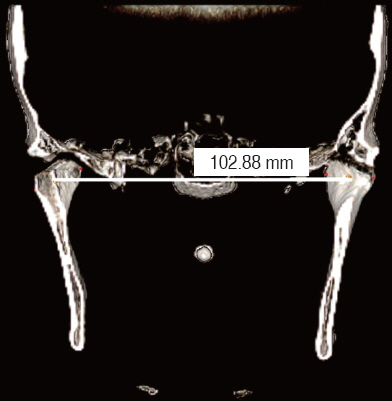J Dent Rehabil Appl Sci.
2018 Jun;34(2):97-103. 10.14368/jdras.2018.34.2.97.
Evaluation of Bonwill triangle using cone beam computerized tomography in Korean
- Affiliations
-
- 1Department of Prosthodontics, College of Dentistry, Wonkwang University, Iksan, Republic of Korea. scoh@wku.ac.kr
- KMID: 2422651
- DOI: http://doi.org/10.14368/jdras.2018.34.2.97
Abstract
- PURPOSE
The aim of this study was to evaluate the Bonwill triangle of Korean using the cone beam computerized tomography (Cone-beam CT).
MATERIALS AND METHODS
120 Koreans (60 males and 60 females) who visited Daejeon Dental College Hospital of Wonkwang University and who underwent the Cone-beam CT were selected. The Cone-beam CT images were analysed with Invivo 5.1 (Anatomage, San Jose, USA). After reorientation of axis, the intercondylar distance was measured by clicking both middle points of condyle. And the condyle-incisor distance was measured by clicking the middle point of condyle and contact point of the mandibular central incisor's incisal edge. The collected data were analysed using the SPSS Version 23.0 (IBM Inc., Armonk, USA) and statistical significance was verified by gender using independent t-test.
RESULTS
The mean intercondylar distance of Korean was 105.9 mm, and the male (108.3 mm) was statistically significantly larger than the female (103.4 mm). The mean condyle-incisor distance of Korean was 105.2 mm, and the male (108.1 mm) was statistically significantly larger than the female (102.3 mm).
CONCLUSION
The mean intercondylar distance of Korean in this study was 105.9 mm that was smaller than well-known 110 mm of Caucasian and the male was statistically significantly larger than the female. Within the limitations of this study, it would be necessary to use the articulator which can adjust the intercondylar distance according to the individual for prosthodontic treatment of Korean.
Figure
Reference
-
References
1. The Academy of Prosthodontics. The glossary of prosthodontics terms. J Prosthet Dent. 2005; 94:10–92. DOI: 10.1016/j.prosdent.2005.03.013.2. Jain AR. Articulators through the years revisited:from 1700 to 1900-part I. World J Dent. 2015; 6:222–5. DOI: 10.5005/jp-journals-10015-1347.3. Lee SH. Fixed prosthodontics. 2nd ed. Seoul: Jisung Publishing Co;2007. p. 101–2.4. Keshvad A, Winstanley RB, Hooshmand T. Intercondylar width as a guide to setting up complete denture teeth. J Oral Rehabil. 2000; 27:217–26. DOI: 10.1046/j.1365-2842.2000.00509.x. PMID: 10784334.5. Tradowsy M. Sex difference in intercondylar distance. J Prosthet Dent. 1990; 63:301–2. DOI: 10.1016/0022-3913(90)90200-V. PMID: 2308090.6. Lazić B, Tepavcević B, Keros J, Komar D, Stanicić T, Azinović Z. Intercondylar distances of the human temporomandibular joints. Coll Antropol. 2006; 30:37–41. PMID: 16617573.7. Lee KY, Lee DJ. A comparative study of teeth and dental arch of Korean and Caucasian. Oral Biol Res. 1993; 71:1–15.8. Song WC, Yun KH, Koh KS. Facial flatness of Korean:using facial depth. Korean J Anat. 2003; 36:499–506.9. Kook YA, Nojima K, Moon HB, McLaughlin RP, Sinclair PM. Comparison of arch forms between Korean and North American white populations. Am J Orthod Dentofacial Orthop. 2004; 126:680–6. DOI: 10.1016/j.ajodo.2003.10.038. PMID: 15592215.10. Hwang HS, Kim WS, McNamara JA Jr. Ethnic differences in the soft tissue profile of Korean and European-American adults with normal occlusions and well-balanced faces. Angle Orthod. 2002; 72:72–80. PMID: 11843277.11. Ferrario VF, Sforza C, Miani A Jr, Colombo A, Tartaglia G. Mathematical definition of the curve of Spee in permanent healthy dentitions in man. Arch Oral Biol. 1992; 37:691–4. DOI: 10.1016/0003-9969(92)90073-H. PMID: 1417519.12. Ferrario VF, Sforza C, Miani A Jr, Tartaglia G. Mathematical definition of the shape of dental arches in human permanent healthy dentitions. Eur J Orthod. 1994; 16:287–94. DOI: 10.1093/ejo/16.4.287. PMID: 7957653.13. Bayome M, Park JH, Kook YA. New three-dimensional cephalometric analyses among adults with a skeletal Class I pattern and normal occlusion. Korean J Orthod. 2013; 43:62–73. DOI: 10.4041/kjod.2013.43.2.62. PMID: 23671831. PMCID: PMC3650215.14. Naji P, Alsufyani NA, Lagravére MO. Reliability of anatomic structures as landmarks in three-dimensional cephalometric analysis using CBCT. Angle Orthod. 2014; 84:762–72. DOI: 10.2319/090413-652.1. PMID: 24364751.15. Beck HO. Choosing the articulator. J Am Dent Assoc. 1962; 64:468–75. DOI: 10.14219/jada.archive.1962.0121. PMID: 13866278.16. Hobo S, Shillingburg HT Jr, Whitsett LD. Articulator selection for restorative dentistry. J Prosthet Dent. 1976; 36:35–43. DOI: 10.1016/0022-3913(76)90231-6. PMID: 787498.17. Oh SC, Kim SG, Kim YJ. An evaluation of curve of Spee using cone beam computerized tomography in Korea. J Dent Rehabil Appl Sci. 2014; 30:93–101. DOI: 10.14368/jdras.2014.30.2.93.18. Lundström A. Some asymmertries of the dental arches, Jaws, and skull, and their etiological significance. Am J Orthod. 1961; 47:81–106. DOI: 10.1016/0002-9416(61)90205-6.19. Williamson EH, Simmons MD. Mandibular asymmetry and its relation to pain dysfunction. Am J Orthod. 1979; 76:612–7. DOI: 10.1016/0002-9416(79)90207-0. PMID: 293132.
- Full Text Links
- Actions
-
Cited
- CITED
-
- Close
- Share
- Similar articles
-
- Three-dimensional imaging modalities in endodontics
- Management of root canal perforation by using cone-beam computed tomography
- Evaluation of interdental distance of natural teeth with cone-beam computerized tomography
- A rare case of dilated invaginated odontome with talon cusp in a permanent maxillary central incisor diagnosed by cone beam computed tomography
- Detection of maxillary second molar with two palatal roots using cone beam computed tomography: a case report





